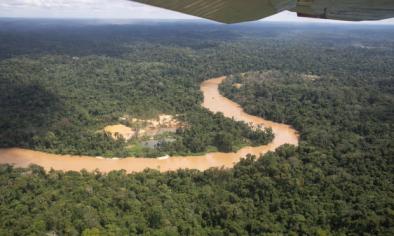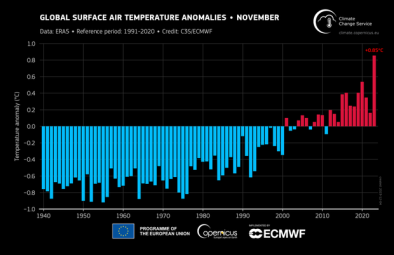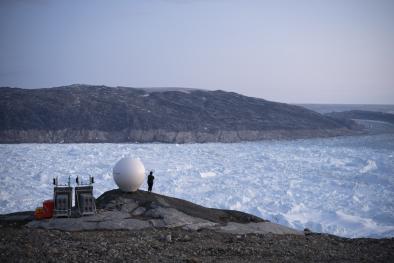Science Source
The Fifth U.S. National Climate Assessment
Study key findings & significance
- The Fifth National Climate Assessment (NCA) is a report developed by the U.S. Global Change Research Program (USGCRP) that provides a thorough, science-based, examination of the effects of climate change on the United States - its people, environment, and economy.
- USGCRP is a federal program mandated by Congress in the Global Change Research Act in 1990 to coordinate federal research and investments “to understand, assess, predict, and respond to human-induced and natural processes of global change.”
- USGCRP produced the first NCA in 2000 and is mandated to deliver an updated NCA to Congress and the President no less than every four years.
- As we grow closer to exceeding 1.5°C of multi-decadal warming in the coming years, the limit enshrined by the Paris Agreement, this report is essential reading, highlighting the seriousness of current impacts and how, despite an increase in adaptation actions across the country, current adaptation efforts and investments are insufficient to reduce today’s climate-related risks and keep pace with future changes in the climate.
Author quotes
"Too many people still think of climate change as an issue that's distanced from us in space or time or relevance," said Katharine Hayhoe, an author of the report and chief scientist at The Nature Conservancy. The assessment “clearly explains how climate change is affecting us here in the places where we live, both now and in the future and across every sector of human and natural society,” Hayhoe said. It also shows that "the risks matter and so do our choices."
Highlights from the science subject-matter findings:
THE SCIENCE IS CLEAR - HUMAN ACTIVITIES ARE WARMING THE GLOBE
- Human activities—primarily emissions of greenhouse gasses from fossil fuel use—have unequivocally caused the global warming observed over the industrial era.
- "About three-quarters of total emissions and warming (1.7°F [0.95°C]) have occurred since 1970." (Ch. 1 Overview)
- It is also unequivocal that global average temperature has risen in response, and that observed warming over the continental United States and Alaska is higher than the global average.
- "The effects of human-caused climate change are already far-reaching and worsening across every region of the United States." (Ch. 1 Overview)
THE CONSEQUENCES OF INACTION ON CLIMATE CHANGE ARE INCREASING
- More expensive disasters: "In the 1980s, the country experienced on average one (inflation-adjusted) billion-dollar disaster every four months. Now, there is one every three weeks on average [all emphases added]." (Ch 1. Overview)
- "Each additional increment of warming is expected to lead to more damage and greater economic losses compared to previous increments of warming, while the risk of catastrophic or unforeseen consequences also increases." (Ch 1. Overview)
- "Harmful impacts from more frequent and severe extremes are increasing across the country—including increases in heat-related illnesses and death, costlier storm damages, longer droughts that reduce agricultural productivity and strain water systems, and larger, more severe wildfires that threaten homes and degrade air quality." (Ch. 1 Overview)
CLIMATE CHANGE EXACERBATES INEQUITIES
- "Climate impacts—combined with other stressors—are leading to ripple effects across sectors and regions that multiply harms, with disproportionate effects on underserved and overburdened communities." (Ch. 1 Overview)
- "The extreme rainfall brought by Hurricane Harvey increased the flooded area in the Greater Houston area by 14%, which led to 32% more homes flooded in Harris County, with a disproportionate impact on low- income Hispanic neighborhoods." (Ch. 2 Climate Trends)
- The spatial distribution of climate impacts partially reflects current and past policy choices: low-income neighborhoods, including those historically affected by redlining or other discriminatory policies, can be as much as 12°F hotter during heatwaves than wealthier neighborhoods in the same city, and are at a substantially higher risk of flooding.
- "Black Americans are more likely to live in older, less energy efficient homes and face disproportionate heat-related health risks." (Ch. 1 Overview)
- "Climate change worsens these long-standing inequities, contributing to persistent disparities in the resources needed to prepare for, respond to, and recover from climate impacts." (Ch. 1 Overview)
LONGER, MORE INTENSE HEATWAVES FUELED BY CLIMATE CHANGE
- "Across 50 large US cities, the US Global Change Research Program heatwave indicator shows that the average number of heatwaves has doubled since the 1980s, and the length of the heatwave season has increased from about 40 days to about 70 days." (Ch. 2 Climate Trends)
- "The impacts of extreme high temperatures are more severe if such conditions persist for several days, and overall, multi-day heatwaves have become hotter, more frequent, larger, and longer-lasting in recent decades." (Ch. 2 Climate Trends)
- "Nighttime temperatures are rising faster than daytime temperatures, and the number of nights where the temperature never falls below 70°F is increasing everywhere in the US except the Northern Great Plains." (Ch. 2 Climate Trends)
- "The extent of CONUS experiencing hot summer nights is growing at a faster rate than the extent experiencing hot summer days."
- "Temperatures are generally lower at night, allowing human (and animal) bodies, crops, and the built environment to cool down. For that reason, an increase in the frequency and intensity of warm nights can have a significant impact on human health, crop yields, and more."
RAINFALL EVENTS ARE BECOMING MORE EXTREME
- "Since the 1950s, there has been an upward trend in heavy precipitation across the contiguous US." (Ch. 2 Climate Trends)
- "The largest increase in the number of extreme precipitation days (defined as the top 1% of heaviest precipitation events) has occurred over the Northeast (an increase of around 60%) and Midwest (around 45%) along with increases of more than 10% in their annual and 5-year maximum amount."
- "There is robust evidence that human-caused warming has contributed to increases in the frequency and severity of the heaviest precipitation events across nearly 70% of the US." (Ch. 2 Climate Trends)
- "Atmospheric rivers along the Pacific coast have become warmer over the past several decades and have transported larger amounts of moisture into the West because of increases in Pacific Ocean temperatures." (Ch. 2 Climate Trends)
DROUGHTS ARE GETTING WORSE
- "Colorado River streamflow over the period 2000–2014 was 19% lower than the 20th century average, largely due to a reduction in snowfall, less reflected sunlight, and increased evaporation." (Ch. 2 Climate Trends)
- "The period 2000–2021 in the Southwest had the driest soil moisture of any period of the same length in at least the past 1,200 years." (Ch. 2 Climate Trends)
- "Much of the US is vulnerable to rapid-onset flash droughts that can materialize in a matter of days, driven by extreme high temperatures or wind speeds and a lack of rainfall." (Ch. 2 Climate Trends)
THUNDERSTORMS ARE CHANGING
- "While the average annual number of tornadoes appears to have remained relatively constant, there is evidence that tornado outbreaks have become more frequent, that tornado power has increased, that tornado activity is increasing in the fall, and that 'Tornado Alley' has shifted eastward."
- The complexes of thunderstorms that bring substantial precipitation to the central United States during the warm season have become more frequent and longer-lasting over the past two decades.
- Days with environmental conditions conducive to producing large hail (>5 cm) have become more frequent over the central and eastern US and parts of the Pacific Northwest.
WILDFIRES ARE BECOMING LARGER, MORE INTENSE, AND MORE FREQUENT DUE TO CLIMATE CHANGE
- From 1984 to 2015, about half of the increase in burned area across the western United States is attributable to increases in fuel flammability caused by anthropogenic climate change.
- Much of the country is experiencing more intense and frequent wildfires associated with warming and drought and aggravated by the reduction in Indigenous land-use and fire stewardship practices that have been critical for past management of fires.
- In the period 1979–2020, human-caused warming was responsible for nearly 68% of the observed increase in aridity in the West, creating the conditions that drove growth in the acreage burned by wildfires.
HURRICANES ARE BEING AFFECTED BY CLIMATE CHANGE
- Tropical cyclones have been intensifying more rapidly since the early 1980s leaving communities with less time to prepare.
- There has been an increase in basin-wide hurricane activity in the North Atlantic since the early 1970s.
- There has been a 17% decrease in the speed of movement of storms in the North Atlantic basin since 1900, as well an increased tendency for storms along the North American coast to meander and stall since the 1950s.
- Slower- moving storms can result in more heavy rainfall, wind damage, storm surge, and coastal flooding. Hurricane damage in the United States has generally increased since 1900, after accounting for changes in the value of property and other assets placed in harm’s way.
SEA LEVEL ALONG THE CONTINENTAL US COAST IS RISING FASTER THAN THE GLOBAL AVERAGE
- Over the past century, average sea level along the continental US coastline has risen by about 11 inches, which is considerably more than the global average sea level rise of 7 inches.
- In just the last three decades (1993–2020), sea level has risen at a rate of 1.8 inches per decade in the continental US compared to 1.3 inches per decade globally.
- Changes in average sea level have doubled the frequency of disruptive high tide flooding in the continental United States over the past few decades.
- In some cities, the increase in flood frequency has been even greater due to locally higher rates of sea level rise—for example, a fourfold increase in the frequency of disruptive high tide flooding events in Miami Beach, Florida, over the last 20 years.
AS THE PLANET WARMS, STORMS WILL BECOME MORE DANGEROUS
- With every increment of global warming, projected sea level rise is very likely to lead to higher storm inundation levels when storms do occur.
- Projected increases in atmospheric water vapor are very likely to lead to more extreme rainfall rates.
- Projected increases in water temperatures are very likely to result in stronger tropical cyclones globally, with winds 5% faster (3% for the Atlantic basin) at a global warming level of 2°C.
- Even in regions that experience an overall decrease in precipitation, atmospheric rivers are projected to become stronger and wider, increasing risk of downpours and floods across the western United States.
- It is likely that the frequency of weather environments that give rise to severe thunderstorms in the United States during spring and fall will increase under stronger warming scenarios.
- These changes are likely to lengthen the severe thunderstorm season as the world warms, especially in the Midwest and Southeast during cool-season months.
SO WHAT CAN WE DO? THE FATE OF THE FUTURE IS IN OUR HANDS
- The more the planet warms, the greater the impacts—and the greater the risk of unforeseen consequences.
- Existing climate pledges, if implemented, would increase the likelihood of limiting temperature change to well below 2°C.
- The degree to which climate change will continue to worsen is in large part up to humans. The drastic emissions cuts required to stabilize global climate are possible and can be achieved in ways that are sustainable, healthy, and fair.
- If emissions do not fall rapidly, the risks of extreme weather, compound events, and other climate impacts will continue to grow. How much more the world warms depends on the choices societies make today. The future is in human hands.
Related Content
Headline

Feb 15, 2024 | Climate Nexus Hot News
Amazon Could Reach Tipping Point By Midcentury
Headline

Jan 16, 2024 | Climate Nexus Hot News
2023 Smashes Hottest Year Record
Headline

Dec 7, 2023 | Climate Nexus Hot News
It’s Official - 2023 Is World's The Hottest Year On Record
Headline

Dec 7, 2023 | Climate Nexus Hot News
Earth Veering Closer To Dangerous Tipping Points


